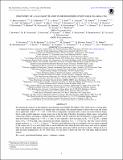Discovery of a gas giant planet in microlensing event OGLE-2014-BLG-1760
Abstract
We present the analysis of the planetary microlensing event OGLE-2014-BLG-1760, which shows a strong light-curve signal due to the presence of a Jupiter mass ratio planet. One unusual feature of this event is that the source star is quite blue, with V-I=1.48+/- 0.08. This is marginally consistent with a source star in the Galactic bulge, but it could possibly indicate a young source star on the far side of the disk. Assuming a bulge source, we perform a Bayesian analysis assuming a standard Galactic model, and this indicates that the planetary system resides in or near the Galactic bulge at DL=6.9+/- 1.1 kpc. It also indicates a host-star mass of M*=0.51-0.28/+0.44M_sun, a planet mass of mp=0.56-0.26/+0.34MJ, and a projected star–planet separation of a_perp=1.75-0.33/+0.34 au. The lens–source relative proper motion is μrel=6.5+/- 1.1 mas yr‑1. The lens (and stellar host star) is estimated to be very faint compared to the source star, so it is most likely that it can be detected only when the lens and source stars start to separate. Due to the relatively high relative proper motion, the lens and source will be resolved to about ∼46 mas in 6–8 yr after the peak magnification. So, by 2020–2022, we can hope to detect the lens star with deep, high-resolution images.
Citation
Bhattacharya , A , Bennett , D P , Bond , I A , Sumi , T , Udalski , A , Street , R , Tsapras , Y , Abe , F , Freeman , M , Fukui , A , Hirao , Y , Itow , Y , Koshimoto , N , Li , M C A , Ling , C H , Masuda , K , Matsubara , Y , Muraki , Y , Nagakane , M , Ohnishi , K , Rattenbury , N , Saito , T , Sharan , A , Sullivan , D J , Suzuki , D , Tristram , P J , Skowron , J , Szymański , M K , Soszyński , I , Poleski , R , Mróz , P , Kozlowski , S , Pietrukowicz , P , Ulaczyk , K , Wyrzykowski , L , Bachelet , E , Bramich , D M , D’Ago , G , Dominik , M , Figuera Jaimes , R , Horne , K , Hundertmark , M , Kains , N , Menzies , J , Schmidt , R , Snodgrass , C , Steele , I A & Wambsganss , J 2016 , ' Discovery of a gas giant planet in microlensing event OGLE-2014-BLG-1760 ' , Astronomical Journal , vol. 152 , no. 5 , 140 . https://doi.org/10.3847/0004-6256/152/5/140
Publication
Astronomical Journal
Status
Peer reviewed
ISSN
0004-6256Type
Journal article
Collections
Items in the St Andrews Research Repository are protected by copyright, with all rights reserved, unless otherwise indicated.

